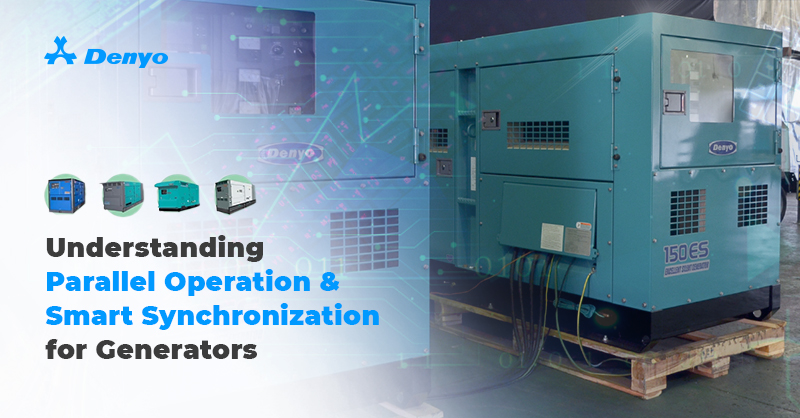In today’s fast-paced world, power reliability is crucial across various industries, from construction sites and large-scale events to critical infrastructures like hospitals and data centers. To meet growing and fluctuating power demands, many operations rely on the parallel operation of generators. But what exactly does parallel operation involve, and how can it improve power efficiency and stability? In this guide, we’ll explore the fundamentals of parallel operation.
What is Parallel Operation?
Parallel operation refers to connecting two or more generators to work in unison, sharing the load of the total power demand. Instead of relying on a single large generator, parallel operation allows multiple generators to synchronize their outputs and collectively provide the necessary power. This increases power availability and offers flexibility, scalability, and enhanced efficiency in handling fluctuating loads. By utilizing parallel operation, industries can ensure a stable power supply while optimizing the use of generators, minimizing fuel consumption, and extending the equipment’s lifespan.
How Parallel Operation Works?
To operate generators in parallel, two key elements must be managed as follows:
- Synchronization: Before generators can operate together, they must be synchronized. This means matching their voltage, frequency, and phase to ensure they work in harmony. Proper synchronization ensures the power they produce is stable and prevents issues like surges or equipment damage.
- Load Sharing: Once synchronized, the generators share the electrical load. Depending on the power demand, the load is distributed evenly across the generators, ensuring no single unit is overloaded. Effective load sharing improves efficiency, reduces wear and tear on equipment, and even helps manage fuel consumption.
Types of Parallel Operation Systems
Parallel operation can be managed through different systems depending on the level of automation and control required. Below are the three main types:
Manual Parallel Operation
- Operation: Engine start/stop, synchronization, and load sharing are all performed manually.
- Advantages: Offers complete control over the process and is cost-effective for smaller operations.
- Challenges: Requires skilled personnel to manage the operation, making it labour-intensive and prone to human error.
- Best Suited for: Small-scale or simple operations where power demand is relatively steady and doesn’t require frequent adjustments.
Semi-Automatic Parallel Operation
- Operation: Combines manual and automatic control. Operators manually start the engines, but synchronization and load sharing can be automated.
- Advantages: Reduces manual intervention for synchronization and load sharing, providing faster response times and improved efficiency.
- Challenges: It still requires some level of manual control, meaning it is not entirely hands-off.
- Best Suited for: Medium-sized operations that need a balance between control and automation.
Fully Automatic Parallel Operation
- Operation: All aspects, from engine start/stop to synchronization and load sharing, are fully automated.
- Advantages: Minimal manual intervention is required, making it highly efficient and ideal for large, complex operations.
- Challenges: Higher initial investment, but offers long-term savings due to automation and fuel optimization.
- Best Suited for: Large-scale or dynamic operations where power needs fluctuate regularly, such as events, data centers, and critical infrastructures.
Benefits of Parallel Operation
- Increased Reliability: By having multiple generators in parallel, the failure of one generator doesn’t lead to a total loss of power. The other units can continue operating, providing a fail-safe solution for critical applications.
- Improved Efficiency: Load sharing ensures that generators run at optimal capacity, reducing unnecessary fuel consumption. The options to add or remove generators depending on demand also helps maintain high efficiency.
- Flexibility and Scalability: With parallel operation, power systems can easily scale up or down as demand changes, providing flexibility for a wide range of applications – from temporary work sites to long-term power solutions.
- Fuel Savings: By optimizing generator output based on load demands, fuel usage is minimized, leading to significant cost savings over time, especially in operations where power needs fluctuate frequently.
Advanced Parallel Operation with Denyo Smart Synchronizing System
Among fully automatic parallel operation systems, the Denyo Smart Synchronization (SmartSYNC) system stands out for its advanced features and flexibility. Powered by the ComAp controller, SmartSYNC allows for seamless synchronization of multiple generators – up to 32 units – to work together automatically.
Here’s what makes the Denyo SmartSYNC System unique:
- Automation for Enhanced Efficiency: SmartSYNC handles every aspect of parallel operation automatically, from engine start/stop to load sharing. This reduces human error and ensures that generators always operate at their most efficient levels.
- Scalability for Large Operations: With the ability to connect up to 32 generators, SmartSYNC provides scalability for large events, construction projects, and critical infrastructure. The system automatically adjusts to changing power demands, ensuring smooth operation.
- Fuel Optimization: By adjusting generator output based on real-time power requirements, SmartSYNC helps optimize fuel usage, reducing overall operational costs while maintaining reliable power delivery.
Why Parallel Operation is the Future of Power Management
In an era where power demands are increasingly complex and unpredictable, parallel operation offers a flexible, scalable, and efficient solution. Whether you opt for manual control or fully automated systems like the Denyo SmartSYNC System, parallel operation ensures that your power supply remains stable, cost-effective, and reliable. Investing in a parallel operation solution guarantees stable power and provides long-term savings through improved fuel efficiency and reduced maintenance costs for industries and businesses looking to optimise their power systems.
As technology advances, systems like SmartSYNC are leading the way in power management, offering the highest levels of automation and adaptability across industries. If you are ready to take your power management to the next level, don't hesitate to contact us for recommendations on a parallel operation system that fits your needs and efficiently scales your power capabilities.


